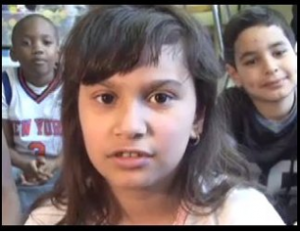Visual Media: A New Literacy
Media literacy educator Frank Baker reminds us that the annual season for movie awards has begun, with the 85th annual Academy Awards scheduled for February 24. In a new two-part article for MiddleWeb, Baker shares key ideas about ways teachers in grades 4-8 can develop students’ visual media literacy skills by (1) involving them in video production like the PSA project described here, and (2) by teaching them to “read” multimedia forms, from magazine layouts to major motion pictures — all of which ties into a pair of Common Core ELA standards.
Do your students love to pick up a camera? Take pictures with their mobile devices? Share photos?
If so, then you know they’re already using photography to communicate a message. Engaging students in taking pictures and having them create and analyze them are important 21st century skills. In education circles, it’s known as “visual literacy.”
I would argue that photographs, as well as moving images, are two of the “new literacies” that all teachers need to recognize and become comfortable with using. When I speak of “moving images” here, I mean internet video, television and motion pictures. We might even call this screen literacy, because they’re being exposed to this media via a screen, whether it’s an inch square or covers the wall of a theatre.
 We know that our students love the movies. For the most part, they can recall the plot, the characters, the action and more. I like to say: they’ve already started down the road to “film literacy” — learning how films communicate.
We know that our students love the movies. For the most part, they can recall the plot, the characters, the action and more. I like to say: they’ve already started down the road to “film literacy” — learning how films communicate.
When most of our students read a passage from a novel (for example) they visualize it by creating a mental image of what they’re reading. In this way, I maintain, they’re already film-makers of a sort but don’t really know it.
In this article, I’d like to zero in on film literacy, including film production by professionals and by students themselves.
The filmmaking process
It’s been my experience that students in classroom situations want to pick up a video recording device and start recording immediately. This often leads to a lot of wasted time that might be used more productively for learning with some front-end preparation and instruction.
With help, students can come to appreciate that filmmaking (e.g. digital storytelling) is a process. This process involves:
1. Writing a script
2. Creating storyboards (visual representations of the scenes in the script)
3. Pre-production
4. Production (shooting the action)
5. Editing to create the final finished product
Allow me to introduce you to some fourth graders from New York City. They worked in class to produce a Public Service Announcement (PSA) about global warming. But they also wanted their audience (teachers/students) to witness and understand the lengthy production process they followed BEFORE they could create their PSA.
In the introduction to their 5-minute video, you’ll meet the students and hear them elaborate on the media making process before showing you their PSA.
It’s a great way to introduce students to the big idea of the film-making process. Teachers will also find links to the teacher’s class blog and to a PSA explaining how students were able to use images in their video, under the fair-use principle of copyright law.
Student PSA project steps
This information is drawn from notes made by the production company that supported the project at the above link.
Class 4-302 at PS 124 brainstormed ways of appealing to their specific audience, and once their attention was held, what they wanted to communicate. The class then divided into four “production units,” each with a specific element of the PSA to communicate: 1) Grab the audience’s attention; 2) define the issue and the audience’s role in it; 3) convey the importance of the issue; and 4) leave the audience with an action to take. Their video also includes an introduction that explains their production process.
 Using a projector, laptop and examples of PSAs on the web, the class analyzed how the PSA video producers used words, images, sound and special effects to inspire their audience to take action.
Using a projector, laptop and examples of PSAs on the web, the class analyzed how the PSA video producers used words, images, sound and special effects to inspire their audience to take action.
Each group (production unit) of students then wrote a script and adapted it for the screen using storyboards. Three of the units shot video sequences based on their storyboards. All units searched for images on the Internet to support their scripts, saved the URL addresses on their class blog, and downloaded selections to experiment with during the editing process. Each unit presented rough cuts to the class on two occasions, and the class evaluated each other’s editing decisions using a rubric.
This production demonstrates how thoroughly a video production can be integrated into a social studies curriculum, while also supporting video editing, internet research basics, media literacy, and critical thinking skills.”
Comments from the adults involved
Teacher Julian Marsano says: “if students are downloading images, for use in a…Public Service Announcement about global warming, it’s really our primary focus that those images have something to do with the big idea of global warming and also with the particular method that the students have chosen to express that message.” Video production, he says, “dovetails with that nicely, because you have to address, in a very conscious way, issues of authorial intention, of objectivity, of tone, of mood, of message, and then, of course, the best way to actually get your message across.”
You can see and hear Marsano and his students here, talking about their teaching and learning.
According to media producer Rhys Daunic, who worked with the New York students, “The abundance of searchable, downloadable images on the Internet, the accessibility of digital music, and the ease with which kids can manipulate and create with them — using free, kid-friendly video editing software — have given teachers low-maintenance opportunities to set up students to experiment with digital productions in the classroom.” Daunic shows how the students learn about media literacy in this clip.
You don’t have to own or purchase thousands of dollars worth of equipment and software to teach students about film-making. Freely available software programs (e.g. Windows Movie Maker, iMovie, Photo Story) are available and are user-friendly.
____
In the next installment of this two-part article, Frank Baker writes about the all-important role of writing and storyboarding in creating visual messages, consider ways to teach students more about “media making & meaning,” share ideas to help kids “read” visual media, and point to standards that tie visual literacy to the Common Core.
 Frank W. Baker is the author of three books; his most recent “Media Literacy In the K-12 Classroom” (ISTE, 2012), is reviewed at MiddleWeb. Previously he wrote “Political Campaigns & Political Advertising: A Media Literacy Guide” (Greenwood, 2009) and “Coming Distractions Questioning Movies” (Capstone Press, 2007) He maintains the nationally recognized Media Literacy Clearinghouse website and conducts media literacy workshops at schools and districts across the US. He is a consultant to the National Council of Teachers of English (NCTE). He can be reached at fbaker1346@aol.com.
Frank W. Baker is the author of three books; his most recent “Media Literacy In the K-12 Classroom” (ISTE, 2012), is reviewed at MiddleWeb. Previously he wrote “Political Campaigns & Political Advertising: A Media Literacy Guide” (Greenwood, 2009) and “Coming Distractions Questioning Movies” (Capstone Press, 2007) He maintains the nationally recognized Media Literacy Clearinghouse website and conducts media literacy workshops at schools and districts across the US. He is a consultant to the National Council of Teachers of English (NCTE). He can be reached at fbaker1346@aol.com.




































There is an outstanding Video Journalism connections/exploratory class at Webb Bridge Middle School in Alpharetta, GA that teaches this very concept to 6th-8th graders! Ms. Jan Bartley is the teacher who has been working her magic every day. Email her at bartleyj@fultonschools.org to get some scoop on her process, too!